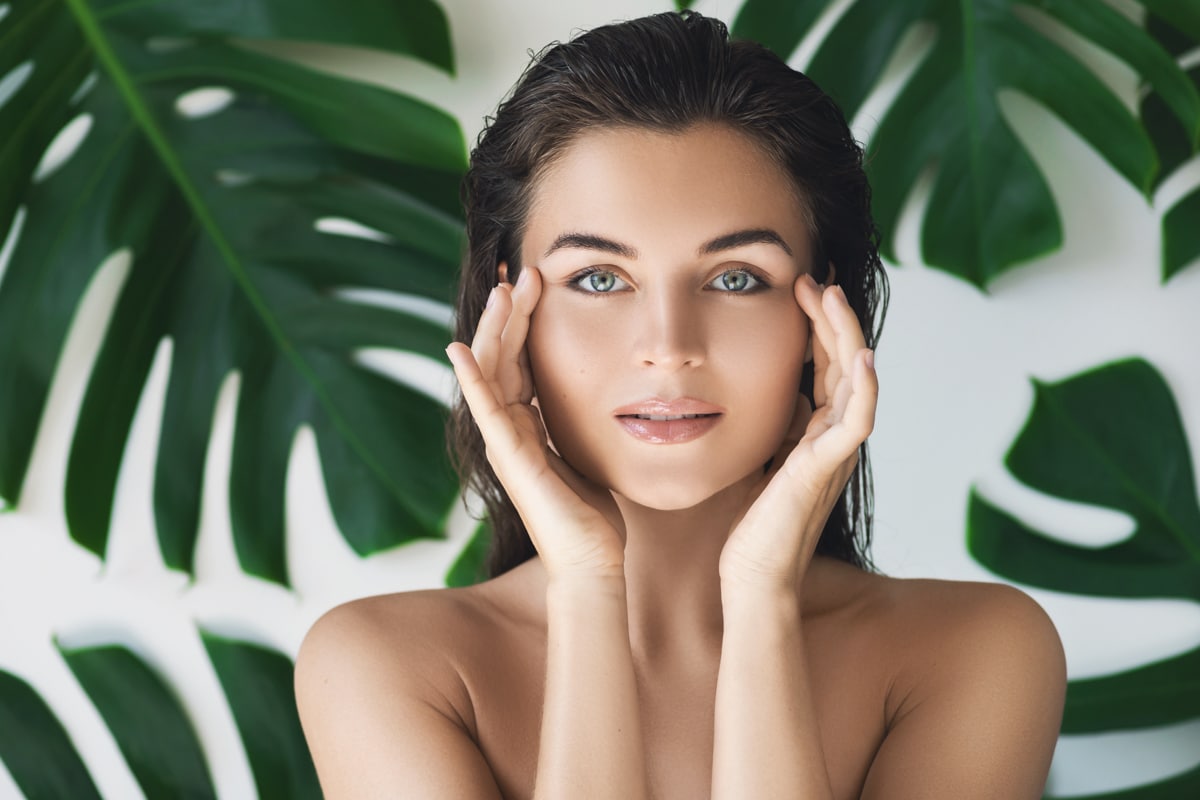The CeraVe healing ointment is, as the name indicates, a balm to relieve cracked, chafed, and extremely dry skin. As you may already know, damaged skin requires special care. This ointment is a great way to soothe the skin by hydrating it. The main ingredients in the formula are 46.5 percent of petrolatum, hyaluronic acid, and ceramides, which help restore the skin’s barrier by temporarily protecting and relieving any damage to it.
Petroleum jelly can ease inflammation and retain skin moisture, relieving the itch and leading to less scratching. In turn, the ceramides help restore and maintain the skin’s natural barrier, while the hyaluronic acid helps retain the natural moisture. This healing ointment contains no lanolin, fragrance, or dyes and is also lightweight, non-comedogenic, and thus, suitable for all skin types.
Per a note on the company’s website, they want prospective customers to be aware that the list of ingredients is regularly updated. You’ll find the full list on this product’s package on their website. Developed by dermatologists, it’s already accepted by the National Eczema Association, which backs up the claim that the product forms a protective layer to enhance the skin’s natural moisture barrier function for up to eight hours. It means it can lock in moisture throughout the night.
CeraVe Healing Ointment Review: Is It Worth It?
This product is petroleum-based, so one would expect it to be thick and difficult to spread. However, it’s thin and smooth, so it’s easy to apply and doesn’t feel heavy on the skin. This healing ointment retains the best of petroleum jelly but is much improved. It’s particularly good for overnight applications, especially for those who regularly use retinoids or undergo chemical peels.
It’s also great for wounds and burns and can soften callouses, especially those on the feet, but it’s also perfect for cracked lips, feet, elbows, and knees. Most CeraVe products are available in various sizes, including convenient travel sizes of three ounces and less.

The Skin Barrier
It’s the outermost layer of the skin and comprises 50 percent ceramides, 25 percent cholesterol, and 10 to 25 percent fatty acids. The depletion of ceramides often results in moisture loss and dryness, and this, in turn, leads to cracking and even inflammation or irritation due to allergens and toxins. A ceramide deficiency can contribute to more serious skin conditions like psoriasis and eczema.
What Are Ceramides and What Do They Do?
Ceramides are lipids that comprise about 50 percent of the skin lipids that form the natural skin barrier. They’re the glue that holds your cells together to keep your skin barrier intact and healthy. A healthy one helps seal in moisture and keep out harmful elements. However, these become depleted over time, so it’s essential to maintain the right balance for optimal skin barrier function and beautiful, healthy-looking skin.
Lower ceramide levels are linked to skin conditions such as acne, eczema, psoriasis, and rosacea. Sun exposure, harsh climates, and age also impact your ceramide levels and can compromise your skin barrier function, contributing to dry skin. Their main function is to lock in moisture, keep irritants at bay, and repair the skin barrier.
Rough Skin Patches 101
These patches usually feel rough to the touch, especially on the hands and feet, and are often the result of dryness and a build-up of dead skin cells. As you probably already know, your skin can renew, although this process slows down as you age. Also, certain skin conditions accelerate the accumulation of dead cells.
The dead cells that lead to the rough patches of skin have an uneven texture and feel coarse to the touch. They can appear anywhere on your body and are either the result of dryness or a buildup of dead skin cells. You can improve their appearance through a combination of exfoliation and hydration.
Rough skin is usually made of dry, scaly skin on the legs and can affect men and women of all ages and appear on the face and any other part of the body, as we mentioned above. Those on the face and neck are often due to shaving. Providing hydration and gentle exfoliation is the best way to help smooth and soften their texture. Salicylic and lactic acids are great for this purpose.
The best prevention mode is to avoid hot, long showers, harsh soaps, vigorous scrubbing, and over-exfoliation. You may also want to avoid tight clothing, and scratchy fabrics as the friction worsen these kinds of skin conditions.
Rough Skin in Various Body Locations
A skin condition may be to blame if a facial moisturizer doesn’t improve dry, rough patches on the skin around the nose, eyebrows, hairline, ears, and neck. As we said above, dry skin on the neck is common in men who shave regularly and might be due to folliculitis, razor burn, or ingrown hairs. You may want to consult a dermatologist to find out if you have psoriasis or eczema and get treatment.
Rough hands, arms, and elbows are usually the result of dry skin. This part of your body is prone to dryness because there are fewer oil glands, and you are constantly exposed to harsh environmental factors. Actions like frequently washing your hands and contact with soaps and other chemicals, as well as extreme weather conditions, deplete moisture from your skin. This kind of dryness could also be due to Keratosis Pilaris. The same goes for the rough skin on your elbows. In this case, the redness covered with rough white patches on the skin of the elbows could be psoriasis, while red ones inside the elbows could be caused by eczema.
The number of oil glands in the feet is also lower than in other parts, so it’s easy for this skin to become thick and dry. The rough patches are calluses. It is due to the friction caused by wearing shoes. Similarly, cracked heels result from the feet supporting your body weight.
Stubborn Patches of Bumpy Skin
Ok so, you’ve tried all kinds of moisturizers and even gentle exfoliation, and the rough, dry patches won’t go away. It may be due to a condition called Ichthyosis Vulgaris, which keeps dead skin cells from shedding. The accumulation resembles fish scales, hence the name. You might want to consult a dermatologist if at-home care doesn’t help improve the look and feel of your rough skin.
The Color of Your Rough Skin Patches
Did you know that the color of rough skin is a telltale of its cause? These are the most common factors that lead to variations in this regard.
White, rough skin on your knees and elbows is usually due to dryness. As we mentioned above, red skin covered by white scales may indicate psoriasis when present on the elbows, knees, and face, although it could affect other areas.
As for the rough red patches, those found inside of the elbow, backs of the knees, and other parts of the body may be due to eczema. However, rough, bumpy skin on the back of your arms or thighs is often the result of Keratosis Pilaris.
Likewise, a dark, rough patch on the skin on your face, arms, or legs could be an Actinic Keratosis, and this is the result of sun damage.
Treatment for Rough, Dry Skin
We’ve already mentioned that dry skin is the main cause of rough spots and that skincare products that moisturize and provide gentle exfoliation are an effective way to help smooth and soften your rough skin associated with dryness.
Hyaluronic acid is a good hydrating agent that helps draw moisture from the environment into your skin. In addition, lotions and creams with ceramides help restore your skin’s barrier and lock in moisture. Similarly, salicylic and lactic acids are great for exfoliating your skin as they promote the shedding of dead cells. It, in turn, helps improve the texture. In addition, skin care products formulated with a soothing ingredient like niacinamide can soothe and keep you comfortable.
Medical Conditions that Cause Dry Scaly Skin Patches
Dry, scaly skin is often the result of a combination of factors. It may be due to a compromised skin barrier that allows moisture to escape. A buildup of dead cells may lead to scaly skin when the skin’s natural renewal process is disrupted. Thus, the natural aging process, exposure to harsh weather, being in the water for long periods, and external irritants can all lead to dry, scaly skin patches.
Ok, so you already know that rough skin can result from mere dryness and that scaly skin could be a symptom of a specific skin condition. Let’s review the various causes.
Eczema
This scaly skin condition is characterized by itchy, dry skin, rashes, scaly patches, blisters, and skin infections. Itchy skin is the most common symptom, and there are seven types of eczema: atopic dermatitis, contact dermatitis, dyshidrotic eczema, nummular eczema, seborrheic dermatitis, and stasis dermatitis.
Eczema is commonly present inside the elbows and behind the knees but can affect any body part. This chronic condition often begins in childhood and is usually triggered by specific environmental factors.
Psoriasis
This chronic scaly skin condition leads to inflamed patches of red skin covered with thick, white scales. It’s usually present on the knees, elbows, lower back, palms, and soles of the feet. Psoriasis is an immune-mediated disease. That is a disease with an unknown cause but characterized by inflammation caused by immune system dysfunction.
It might happen because the overactive immune system speeds up skin cell growth. In normal skin, the cells grow entirely and fall off in about a month. But, this process happens in only three or four days in people with psoriasis. The dead cells pile up on the skin’s surface instead of shedding. These patches are usually itchy and may also burn and sting. They can affect any body part but are most common on the elbows, knees, and scalp.
The inflammation caused by this condition can impact other organs and tissues in the body, and people afflicted by it may also experience health conditions like psoriatic arthritis. It includes swelling, stiffness, and pain in the joints and areas surrounding them, although it often goes undiagnosed, especially when it’s mild. Note that it’s important to treat it in the early stages to prevent further joint damage. The symptoms usually start during the teenage years and end around the mid-20s but could start and end at any age. The condition affects any gender and ethnicity.
Keratosis Pilaris
This common skin condition can affect any person at any age. But, it’s more common and most often seen in children and teenagers. Keratosis Pilaris causes rough, bumpy skin patches, but it’s usually harmless and painless. It’s often referred to as chicken- or strawberry-skin due to its goose bump-like appearance and is most commonly present on the thighs, cheeks, buttocks, and the backs of the upper arms.
The pimple-like bumps are due to a build-up of keratin, a skin protein that blocks your hair follicles. It’s not yet clear why certain people are more predisposed to it, but some dermatologists believe it’s genetic. Hormones possibly trigger it in teenagers as most flare-ups happen during puberty. Most cases of keratosis pilaris will clear up as people age.
These bumps are often surrounded by red, scaly skin that’s itchier and more noticeable on dry skin and are an ongoing cosmetic concern for many. It leads to feelings of self-consciousness when wearing sleeveless tops or shorts. There’s currently no cure for this condition, but topical creams, lotions, and cleansers can improve your skin’s appearance.
Seborrheic Dermatitis
This condition is often responsible for the flaky, scaly skin on the scalp, eyebrows, sides of the nose, and behind the ears. You probably know it as dandruff. The condition is common, noncontagious, and easy to manage. The most characteristic signs are itchy red patches and greasy scales on your skin. It leads to a whitish-yellowish crust of powdery flakes on your scalp.
Seborrheic dermatitis is a lifelong condition that appears, disappears with treatment, and then flares up again from time to time. It usually affects the areas with the most sebaceous gland activity. We refer to it as “dandruff” when it happens on the scalp of a grown-up and “cradle cap” when it’s on a baby’s.
Actinic Keratosis and Skin Cancer
Also known as Solar keratosis, this condition is the most common precancer that forms individual scaly patches on the skin that’s been overly exposed to the sun if not treated early on.
The condition results from long-term exposure to ultraviolet radiation, as we mentioned above. You’re more likely to develop more actinic keratoses in the future if you already have a patch. It, in turn, puts you at greater risk for skin cancer as the lesions can develop into squamous cell carcinoma, a common, sometimes invasive form of this disease.
Ichthyosis Vulgaris
This common genetic skin condition keeps dead skin cells from shedding naturally, so they accumulate and look like fish scales. You can usually control mild cases by applying a moisturizer regularly.
The main characteristic of Ichthyosis Vulgaris is excessively dry, scaly skin, which may or may not be genetic.
Athlete’s Foot
It’s a common fungal infection that affects the feet, and you can usually keep it at bay with over-the-counter lotions, sprays, or powders, although it continues to come back. The most characteristic symptoms of athlete’s foot are itchy white patches between your toes. It could also cause sore and flaky patches on your feet.
The skin can look red; sometimes, the skin becomes cracked, leading to bleeding. Athlete’s foot can also affect the soles and sides of your feet and manifest as fluid-filled blisters. If not treated on time, this infection will spread to your toenails and cause a fungal nail infection.
In Conclusion
CeraVe Healing Ointment seems to be a great product, and people who’ve used it speak highly of it. Many say it’s like a dream come true for rough winter feet. Others say that no more dried-out heels and rough calluses after using this wonder ointment. People generally obtain good results when they use it to reduce the appearance of eczema and love the price (about 20 USD) as much as they love the immediate results. Other use it for slugging and swear by it, although they also like to use it to relieve their dry, cracked lips. In short, the healing ointment is a game-changer that can moisturize your skin and give it a healthier appearance in a few days. Check it out.








